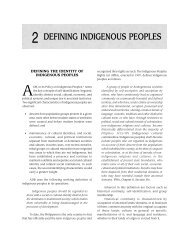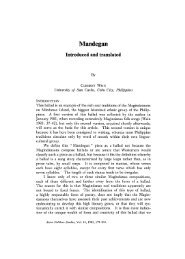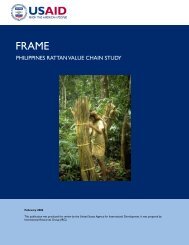Deaf Awareness - Philippine Culture
Deaf Awareness - Philippine Culture
Deaf Awareness - Philippine Culture
Create successful ePaper yourself
Turn your PDF publications into a flip-book with our unique Google optimized e-Paper software.
ungol!<br />
EAF!<br />
mang!<br />
earing impaired!
What do I know about them<br />
What do I think when I see them<br />
How do I feel when I see them
Let’s Have A Short Quiz!
TRUE<br />
OR<br />
FALSE
<strong>Deaf</strong> people<br />
are mute
<strong>Deaf</strong> people<br />
are dumb
All <strong>Deaf</strong> people<br />
are excellent<br />
lip-readers
Sign language<br />
is<br />
UNIVERSAL
EAFinitely!<br />
MISCONCEPTIONS
Basic<br />
A<br />
Facts
Two (2) Perspectives on <strong>Deaf</strong>ness<br />
(as described by Baker and Cokely, 1980)<br />
• The Medical-Pathological Model<br />
• The Cultural Model
Medical-Pathological Model<br />
“deafness is a terrible tragedy<br />
and <strong>Deaf</strong> people are to be<br />
pitied.”
Cultural Model<br />
- common language<br />
-<strong>Culture</strong><br />
-social affiliation<br />
-educational background.
Welcome to the <strong>Deaf</strong> world!
Comparison of two models<br />
Medical Model Point of comparison Cultural Model<br />
<strong>Deaf</strong>ness is a disability Definition <strong>Deaf</strong>ness is a<br />
difference<br />
Professionals must be<br />
concerned with<br />
“saving” the <strong>Deaf</strong><br />
Professional<br />
involvement<br />
We must work with the<br />
<strong>Deaf</strong> about issues and<br />
concerns for their<br />
welfare.<br />
The <strong>Deaf</strong> belong to the<br />
disability sector of the<br />
society.<br />
Membership in the<br />
society<br />
The <strong>Deaf</strong> belong to a<br />
linguistic minority<br />
sector.<br />
Speech<br />
Real handicap of<br />
deafness<br />
The Area of<br />
Communication
Types of <strong>Deaf</strong>ness<br />
Pre-lingually <strong>Deaf</strong><br />
Post-lingually <strong>Deaf</strong>
Causes Of <strong>Deaf</strong>ness<br />
• Perinatal<br />
• Accidental/traumatic<br />
• Ageing<br />
• Heredity<br />
• Medical
Degree of <strong>Deaf</strong>ness<br />
DEGREE DECIBELS SOURCE OF SOUND<br />
MILD 20-40 dB Alarm clock<br />
MODERATE 41-70 dB Loud radio<br />
SEVERE 71-95 dB Chainsaw<br />
PROFOUND 95+ dB Airplane noise
iPods,Mpe3s<br />
can reach up to 115 dB<br />
or even higher<br />
SOURCE OF SOUND<br />
DECIBELS<br />
Listening to TV/ normal talking 40-60<br />
Traffic noise/moving car 80-90
In the 2005 Census for <strong>Deaf</strong><br />
population in Cebu province<br />
Female:<br />
Male: Children<br />
<strong>Deaf</strong> : 14,491 14,144 *
World Health Organization<br />
statistics for <strong>Deaf</strong>ness:<br />
one <strong>Deaf</strong> per 1000 population
Current Issues<br />
High prevalence/incidence of <strong>Deaf</strong>ness in the <strong>Philippine</strong>s:<br />
2-3: 1000 Filipinos<br />
-lack of accessibility<br />
-basic services for the <strong>Deaf</strong>
Current Issues<br />
65-70% of <strong>Deaf</strong> boys and girls are being molested<br />
-source: The <strong>Philippine</strong> <strong>Deaf</strong> Resource Center<br />
1 out of 3 <strong>Deaf</strong> women has been raped<br />
- source: Lyer and Fortunato, 2005<br />
72%- abused or battered<br />
63%- abused by their own fathers.<br />
- source: De Guzman, 2002
Current Issues<br />
50% of <strong>Deaf</strong> girls have been sexually<br />
abused as compared to 25% of hearing<br />
girls.<br />
54% of <strong>Deaf</strong> boys have been sexually<br />
abused as compared to 10% of hearing<br />
boys.<br />
Source: Patricia M. Sullivan, Vernon & scanlan, 1987
<strong>Philippine</strong> Laws that<br />
protect<br />
Persons With<br />
Disabilities (PWDs)<br />
including the <strong>Deaf</strong>…
1987 <strong>Philippine</strong> Constitution<br />
•R.A 9422 (Magna Carta for the Differently abled)<br />
Public Ridicule<br />
Vilification<br />
•Convention on the rights of the child<br />
•Convention on the Rights of Persons with disabilities<br />
•R.A 7610( Special Protection of children Against Abuse, Exploitation and Discrimination Act)<br />
•R.A 9262 ( Anti-violence against Women and their children Act 2004)
“The only thing a <strong>Deaf</strong> person<br />
cannot do is hear”.<br />
-I.King Jordan<br />
•Other senses of the <strong>Deaf</strong><br />
are often well developed<br />
and allow them to adapt to<br />
almost anything.
Let’s<br />
EAF
ard of hearing<br />
cannot detect sound at an<br />
amplitude of 20 decibels
earing impairment<br />
less-than-normal hearing
can be present at birth or<br />
caused suddenly by<br />
disease/injury
<strong>Deaf</strong>ness and Diversity<br />
• Culturally <strong>Deaf</strong> persons<br />
• Orally <strong>Deaf</strong> persons<br />
• Hard of hearing persons<br />
• Persons with acquired deafness
eaf &<br />
eaf<br />
what’s the difference
eaf<br />
is a general term to<br />
refer to the person<br />
who cannot hear
Filipino <strong>Deaf</strong><br />
Community<br />
It is cultural linguistic minority. It<br />
is an ethnic group with it’s own<br />
cultural heritage, language and<br />
psychology.
ilipino<br />
eaf
eaf
Distinct Characteristics of <strong>Deaf</strong> People<br />
• When mainstreamed with hearing people, without moving,<br />
they can be mistaken as hearing.<br />
• They make peculiar movements and sounds when<br />
communicating.<br />
• They show feelings in exaggerated appearance.<br />
• Views the surroundings and happenings in the world in a<br />
different way according to what they see.
Distinct characteristics of <strong>Deaf</strong> People<br />
• They easily feel the change of mood.<br />
• It is imbedded in their emotions the feeling of<br />
deprivation.<br />
• They are very loyal to the people.
Unacceptable<br />
terms used to<br />
describe the <strong>Deaf</strong>
ABNorMAL!<br />
Hearing-Impaired<br />
DiMalas!<br />
Amang<br />
Buangbuang<br />
Special<br />
Kawawa<br />
BOGO<br />
deaf-dumb<br />
Inutil!<br />
<strong>Deaf</strong>-mute<br />
Salot sa Pamilya<br />
Retarded
eaf<br />
Bungol rather than amang
eaf community<br />
•sees deafness as a difference<br />
rather than a pathology or an<br />
illness to be cured.
eaf culture<br />
<strong>Deaf</strong> life<br />
<strong>Deaf</strong> experiences….
What is Filipino <strong>Deaf</strong> <strong>Culture</strong><br />
• unique way of life<br />
• evolved from Filipino <strong>Deaf</strong><br />
communities<br />
• sharing of experiences
Is there really<br />
a Filipino <strong>Deaf</strong> <strong>Culture</strong><br />
• Enlightened Filipino <strong>Deaf</strong> adults and<br />
adolescents (with their hearing<br />
advocates) believe there is!<br />
•FSLhighlights Filipino <strong>Deaf</strong> culture
How to get the attention<br />
of a <strong>Deaf</strong> person.
• For many <strong>Deaf</strong>, there is<br />
often little to no<br />
communication in the<br />
home.
• It is best for the<br />
hearing to sign when<br />
in the presence of<br />
the <strong>Deaf</strong>.
Communication is key within the Family for a <strong>Deaf</strong> child and if a family<br />
don’t know how to sign, a <strong>Deaf</strong> may feel excluded or confused.
The <strong>Deaf</strong> sometimes don’t realize that they are making<br />
sounds. For example, the spoon and fork when eating (or<br />
others like the banging of the door, dragging the chair, etc.)
The <strong>Deaf</strong> will not fully understand a lesson if a teacher does<br />
not use sign language to explain the discussion.
Hearing people use the phone to call each other. <strong>Deaf</strong> people<br />
makes use of the SMS technology to communicate to both<br />
<strong>Deaf</strong> and hearing.
<strong>Deaf</strong> people may sign something that is wide and might hit the<br />
person standing next to them. But this is purely accidental. In<br />
<strong>Deaf</strong> conversations, every gesture is very important and<br />
sufficient signing space is needed for arm movements.
Television often do not have caption so <strong>Deaf</strong> people do not<br />
understand what is being said on the TV. <strong>Deaf</strong> people miss<br />
out on the information.
With a sign language interpreter signing in a small inset on the<br />
lower part of the TV, <strong>Deaf</strong> people would have access to<br />
information from the news.
The <strong>Deaf</strong> could participate in the church mass or worship<br />
services if there is a sign language interpreter or the priest<br />
himself would sign the mass.
•Name signs are a very important<br />
part of <strong>Deaf</strong> culture. There are rules the<br />
<strong>Deaf</strong> follow when making up name signs,<br />
hence the reason only a <strong>Deaf</strong> person is<br />
supposed to give you a name sign. The<br />
name sign often reflects a physical<br />
characteristic (hair length, dimples, a scar) or<br />
it can be related to your personality or job.<br />
Once given a name sign, it is how the <strong>Deaf</strong><br />
community recognizes you.
Getting Started:<br />
It is important to get your message<br />
across, to connect and to be<br />
understood when communicating<br />
with a <strong>Deaf</strong> person.
Communicating with the <strong>Deaf</strong>
Gestures / Body movements<br />
Pantomimes<br />
Facial Expressions
Pen and Paper for short<br />
messages
• By asking trained interpreters to<br />
express your message to the <strong>Deaf</strong><br />
(keep in mind to speak to the <strong>Deaf</strong> not the interpreter)<br />
• Learn fingerspelling.
Communicating with the <strong>Deaf</strong><br />
( General Communication Principles)
• Get the <strong>Deaf</strong> person’s s attention before<br />
signing or making a gesture.<br />
• Speak slowly and clearly.<br />
• Look directly at the <strong>Deaf</strong> person.<br />
• Do not place anything in or over your<br />
mouth or try to cover your mouth when<br />
you speak.
• Avoid jargons.<br />
• Do not pretend that you understand<br />
what they said.<br />
• Always provide for an FSL interpreter.
I can Do it!!!!!!
How long will it take for me to<br />
learn how to sign
Let’s SIGN!
Elements of Signing<br />
• Signing space<br />
• Hand shape<br />
• Location<br />
• Movement<br />
• Palm orrientation<br />
• Non- manual sign
NON-MANUAL SIGNALS<br />
• Facial expressions<br />
• Non-manual Signal
Face or body part Non-manual signs Ex:word/sentence<br />
brows<br />
eyes<br />
Wrinkle<br />
up<br />
Gaze up<br />
Gaze on hand<br />
Don’t understand<br />
yours<br />
Lizard<br />
Civil marriage<br />
nose wrinkle Smelly: disappointed<br />
lips<br />
cheek<br />
Mouth<br />
Pout<br />
Bite lower lip<br />
Retracted lower lip<br />
Contorted to the side<br />
One cheek puff<br />
Two cheek puff<br />
Cheek sucked in<br />
Round mouth-lip press<br />
Lips pressed-teeth clenched<br />
Lip pressed-tongue low<br />
Teeth biting movements<br />
Tongue low back-rounded<br />
Dog/humble/cigarette<br />
Have<br />
Bat<br />
dentist<br />
Menstruation<br />
Full<br />
thin<br />
Low battery<br />
Same<br />
Yuck<br />
Biscuit<br />
zero
mouthing<br />
Tongue<br />
Eyes and head<br />
Lips<br />
Tongue low front<br />
Wala pa; pagod<br />
Tongue movement<br />
Tongue on cheek<br />
Tongue out<br />
Eyes blink and head nod<br />
Eyes gaze side, head tilt side<br />
Eyes close, head tilt back<br />
Stuck<br />
Garbled<br />
Candy<br />
To kill/dead<br />
Waste/frustrate<br />
Don’t believe<br />
Deep sleep<br />
Brows and head Brows up,head tilts back Understand<br />
Facial expression<br />
Head<br />
Shoulder<br />
Grieved, sour taste<br />
Swift head back movement<br />
Two shoulders up<br />
Sampalok<br />
Got it<br />
I don’t know
Getting to know You signs<br />
• Me name……( My name is..)<br />
• Me sign name…..( my sign name is..)<br />
• You name what...( what’s your name)<br />
• Old you......( how old are you)<br />
• Nice meet you…( its nice to meet you)
W- Questions:<br />
• What<br />
• Who<br />
• When<br />
• Why<br />
• Which<br />
• How
Greetings/ Conversational
Greetings/ Conversational
Days and Time
People/ places/events/animals/actions
Vocabulary
Vocabulary
IMPORTANT POINTS:<br />
• How do I become better in sign<br />
language<br />
• I don’t know the sign for this certain<br />
word<br />
• Which hand should I use Left hand or<br />
right hand
8 Tips for Encouraging Self-Esteem<br />
in <strong>Deaf</strong> and Hard of hearing Children<br />
--2002<br />
2002-2003, 2003, Paula Rosenthal and Taylor,Rose, , Inc.<br />
• 1. Let the child speak.<br />
• 2. Treat the child the same.<br />
• 3. Teach the child manners.<br />
• 4. Teach the child about hearing loss.<br />
• 5. Discover the child's interests and develop them.<br />
• 6. Avoid labeling.<br />
• 7. Teach the child self-acceptance.<br />
• 8. Acknowledge both success and attempts at<br />
success.
“ KINDNESS is a language which the<br />
<strong>Deaf</strong> can hear and the Blind can see.”<br />
-Mark Twain<br />
“Pangga-a sab KO……”
Break the Silence!<br />
Contact us:<br />
The Gualandi Volunteer Service Programme,Inc<br />
Mr. John Paul E. Maunes,RN<br />
Program Manager<br />
Cel.no. 0932 202 7333<br />
Tel.No. 032-231 2601<br />
Email add. gualandivolunteers@ yahoo.com<br />
Website: gualandivolunteers.org<br />
We Can Make a <strong>Deaf</strong>-ference!
Active Participation and Partnership for Protection,<br />
Justice, and Accessibility for the <strong>Deaf</strong>

















